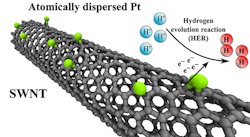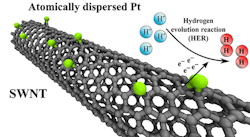Catalyst Pares Platinum But Not Performance
Using carbon nanotubes (CNTs), researchers in Finland have developed an electrocatalyst that achieves similar activity to commercial ones but uses only 100th the amount of platinum. Such an electrocatalyst might enable effective and inexpensive renewable energy systems that don’t require large, expensive amounts of platinum, they believe.
Led by professors Tanja Kallio and Kari Laasonen at Aalto University, Aalto, Finland, researchers used a simple and ready-to-scaleup electroplating deposition method to disperse platinum on the sidewalls of single-walled carbon nanotubes (SWCNTs).
“When platinum is electrodeposited on the surface of carbon nanotubes, it forms particles consisting of a couple of atoms. On other materials, such as graphene, platinum forms larger nanoparticles,” Kallio explains.
Figure 1. Carbon nanotubes stabilize single platinum atoms for more efficient reactions on their surfaces, compared to conventional platinum nanoparticles. Source: Aalto University.
“We believe this is because the carbon atoms of the curved surface are in a strained state, which makes them prone to stabilizing platinum on the surface of the nanotube. This ensures that the platinum atoms form small and catalytically active particles. Our modeling showed that the more strained the carbon bonds are, the better the stabilization of the platinum. Smaller tubes are more curved, which makes the strain greater, so the diameter of the nanotubes is also important,” she adds.
In small-scale conditions and at room temperature, the electrocatalyst is stable and usable for a long time, the researchers report. The next step, they add, is to increase the scale of production and test the functionality of the electrocatalyst in practical applications, which often are carried out at a higher temperature. This includes testing the catalyst material in a laboratory-scale electrochemical cell with active surface area of some 5 cm2. To do this, some 500 mg of the catalyst material is needed, say the researchers.
[callToAction ]
“The Pt is already very finely dispersed and the dispersion cannot be increased much. The coverage of the Pt on the CNT is also rather high. For hydrogen evolution reaction (HER), the Pt mass normalized activity is better for the 200-SWNT sample than 400-SWNT sample. The 400-SWNT material has lower Pt loading than the commercial Pt/C, and is as active as the commercial one. However, it does not have optimal Pt mass normalized activity. For other reactions, like oxygen reduction reaction, larger Pt clusters may be needed and they can be produced with more electrochemical cycles,” they explain.
The amount of Pt is easy to adjust by altering the number of the electrochemical cycles. However, higher Pt loading leads to larger Pt clusters, so the system is no longer at pseudo-atomic-scale, they note.
The team has tried a few other metals, such as Au, but they also produced relatively large clusters. “…some noble metals can be deposited in a similar manner, but the procedure will vary from metal to metal and we have not investigated much the other metals. The attachment of the metal to the CNT varies so one cannot expect every metal to form a pseudo-atomic-scale system. The computational modeling easily will give information on the metal-CNT interactions,” says Laasonen.
“We consider this kind of catalyst particularly useful for hydrogen oxidation reaction in a fuel cell, as no other material in addition to Pt is known to electrocatalyze this reaction in acidic media,” notes Kallio. CNT manufacturers, she adds, have been particularly interested in this study.
A recent article in ACS Catalysis provides more details on the project.

